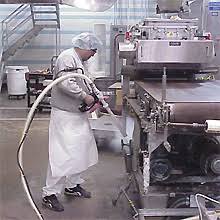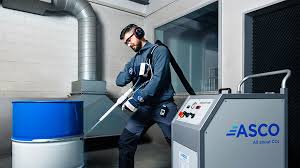 Business
Business
How Dry Ice Blasting Works for Efficient Industrial Cleaning
- by raza
How Dry Ice Blasting Works in Industrial Cleaning
For manufacturing and production settings to remain efficient, safe, and hygienic, industrial cleaning is crucial. Dry ice blasting is one of the most cutting-edge and eco-friendly techniques currently in use. Solid carbon dioxide (CO₂) is used in this cutting-edge cleaning method to eliminate impurities without causing equipment damage or producing secondary waste. We’ll examine the operation of dry ice blasting and the reasons it’s revolutionizing industrial cleaning in this post.
What Is Dry Ice Blasting?
Dry ice blasting is an environmentally friendly, non-toxic, and non-abrasive cleaning method that cleans surfaces using compressed air-driven dry ice pellets. Dry ice blasting eliminates the need for abrasive liquids or particles, in contrast to more conventional techniques like sandblasting or water jetting. Rather, it lifts impurities without damaging the surface by using frozen CO₂ pellets that sublimate—that is, change straight from solid to gas—when they come into contact with an object.
This makes dry ice blasting perfect for sectors like food processing, electronics, aerospace, and automotive where equipment preservation and cleanliness are of utmost importance.
The Science Behind Dry Ice Blasting
Dry ice blasting works through a combination of three physical effects:
1. Kinetic Impact
Compressed air is used to propel dry ice pellets, which are typically 3 mm in diameter, through a nozzle at supersonic speeds. The pellets generate a strong kinetic impact that dissolves the link between the contaminant and the substrate when they come into contact with a dirty surface.
2. Thermal Shock
Because dry ice is extremely cold (-78.5°C or -109.3°F), it causes a sudden temperature drop upon contact. This thermal shock leads to micro-cracking and contraction of the unwanted material, loosening its grip on the surface beneath it.
3. Sublimation and Expansion
Dry ice instantly sublimates, changing from solid to gas without becoming liquid, as it comes into contact with the surface. The CO₂ swells to 800 times its initial volume during this process, causing a minuscule explosion that takes the contaminant away.
When combined, these effects provide a thorough cleaning without causing grit or moisture buildup or harming the underlying substance.
Key Advantages of Dry Ice Blasting
Dry ice blasting offers several significant benefits over traditional industrial cleaning methods:
– Non-Abrasive
It cleans without scratching or eroding surfaces, making it safe for delicate machinery and electronics.
– No Secondary Waste
Since dry ice sublimates into gas, there’s no leftover blasting media to clean up—only the removed debris needs disposal.
– Eco-Friendly
Dry ice is made from recycled CO₂, so the process is carbon-neutral. It also eliminates the need for chemical solvents.
– Minimal Downtime
Machines can often be cleaned in place (CIP), reducing downtime and increasing productivity.
– Safe for Sensitive Areas
Non-conductive and non-flammable, dry ice blasting is ideal for cleaning electrical components or areas where fire risks exist.
Industrial Applications of Dry Ice Blasting
Dry ice blasting is used across a wide range of industries, each with unique cleaning needs:
1. Food and Beverage Industry
It removes baked-on residues, grease, and mold from ovens, mixers, and conveyors. The process is FDA- and USDA-approved and doesn’t contaminate surfaces.
2. Automotive and Aerospace
Used to clean engine parts, molds, and production equipment without disassembly. It prevents wear and maintains precision.
3. Electronics and Electrical
Cleans control panels, circuit boards, and turbines safely due to its non-conductive nature.
4. Manufacturing Facilities
Removes paint, oil, adhesives, rubber, and ink from machinery and molds. It’s perfect for injection mold maintenance.
5. Historical Restoration
Gently strips away soot, mold, and old paint from historic buildings and delicate surfaces without damage.
How the Equipment Works
A typical dry ice blasting setup includes:
- Dry Ice Blaster: A machine that stores and feeds dry ice pellets into the system.
- Air Compressor: Supplies high-pressure air to propel the pellets.
- Nozzles and Hoses: Designed for specific applications, controlling speed, pressure, and spread.
- Dry Ice Pellets: Freshly produced CO₂ pellets stored in insulated containers to prevent sublimation.
Operators adjust air pressure and pellet flow rate depending on the surface and contaminant to be removed.
Safety Considerations
While dry ice blasting is safe when performed properly, some precautions are necessary:
- Ventilation: Proper airflow is critical, as CO₂ gas can displace oxygen in confined areas.
- PPE Required: Operators must wear protective gloves, goggles, and ear protection.
- Training: Only trained personnel should operate blasting equipment to ensure safety and effectiveness.
Limitations to Consider
Despite its many benefits, dry ice blasting may not be suitable for every situation:
- Upfront Costs: Equipment investment can be high, though it often pays off in the long term.
- Pellet Storage: Dry ice must be used promptly as it sublimates over time.
- Surface Compatibility: May not be appropriate for brittle or highly porous materials.
Conclusion
One of the most efficient and ecologically friendly methods for industrial cleaning is dry ice blasting. It assists companies in maintaining their equipment and facilities without the use of harsh chemicals, water, or abrasive media by fusing speed, safety, and cleanliness.
Whether you’re operating a food plant, a manufacturing line, or a maintenance crew, dry ice blasting offers a sensible approach to clean faster, decrease downtime, and protect your costly equipment. Dry ice blasting is still proving to be a valuable, innovative industrial maintenance option as more companies look for eco-friendly and effective cleaning techniques.









